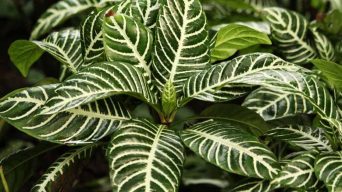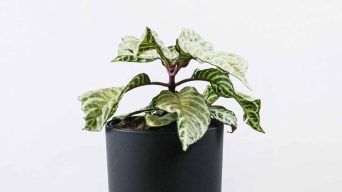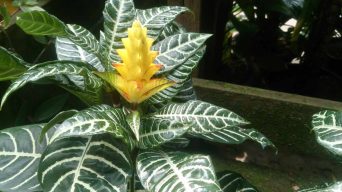The Aphelandra squarrosa, commonly known as the Zebra plant, is a beautiful, easy-to-care-for houseplant that can brighten any room.
But what do you do when your zebra plant starts to die?
There are several reasons why a zebra plant might start to die, but there are also several solutions.
You can save your dying zebra plant with some detective work and TLC.
How To Tell if Your Zebra Plant Is Dying
The first step in saving a dying zebra plant is to figure out why it is dying.
There are several potential causes, and the solution will vary depending on the cause.
Here are some common signs that your zebra plant is dying:
- The leaves are wilting. When the leaves of a zebra plant start to wilt, it is often a sign that the plant is not getting enough water.
- The leaves are turning yellow. If the leaves of your zebra plant are turning yellow, it could be a sign of overwatering or a nutrient deficiency.
- The leaves are turning brown. If the leaves of your zebra plant are turning brown, it could be a sign of too much sun exposure, or it could be a sign of a pest problem.
- The leaves are falling off. If the leaves of your zebra plant are falling off, it could be a sign of too much or too little water, a nutrient deficiency, or temperature stress.
- The leaves edges are browning. If the edges of the leaves of your zebra plant are browning, it could be a sign of too much sun exposure or wind damage.
- Brown or black spots appear on the leaves. If black or brown spots appear on your zebra plant’s leaves, it could be a sign of a fungal disease.
- The plant is not growing. If your zebra plant is not growing, it could be a sign of too little light, too much water, or a nutrient deficiency.
- The flowers are dropping off. If the flowers of your zebra plant are dropping off, it could be a sign of too little light, too much water, or a nutrient deficiency.
These are just some signs that your zebra plant has a problem.
Once you have determined that your zebra plant is indeed dying, it’s time to figure out the cause so that you can take steps to save it.
Why Is Your Zebra Plant Dying and How To Fix It
There are some reasons why your zebra plant might be dying, but there are also solutions to each problem.
1. Not Enough Water
One of the most common reasons for a zebra plant to die is that it isn’t getting enough water. These plants are native to tropical regions and require consistent moisture to thrive.
They need to be watered regularly, especially during the warmer months.
If the soil around your plant is dry, give it a good watering.
Be sure to water at the base of the plant so the water can reach the roots.
How To Tell If Your Zebra Plant Needs Water
There are a few telltale signs that your zebra plant is thirsty:
- The leaves are drooping
- The leaves are turning yellow
- The leaves are wilting
If you let your plant go too long without water, the zebra plant leaves will start to droop, turn brown, and fall off.
How To Save a Dying Zebra Plant From Drought
If your zebra plant is already showing signs of drought stress, there are a few things you can do to save it.
- Move the plant to a location with more humidity.
- Give the plant a deep watering.
- Water the plant more frequently.
2. Too Much Water
While insufficient water is a common problem, too much water can kill an Aphelandra squarrosa.
These plants are susceptible to root rot, which can occur when the roots are left wet for too long.
If you think your plant might be overwatered, check the soil.
If it’s soggy or mushy, it’s a sign that the plant is getting too much water.
How To Tell If Your Zebra Plant Is Getting Too Much Water
There are a few signs that your zebra plant is getting too much water:
- The leaves are wilting
- The leaves are turning yellow
- The leaves are browning
- The leaves are falling off
- The stems are mushy
Check the soil if you think your plant is getting too much water.
If it’s soggy or mushy, it’s a sign that the plant is getting too much water.
How To Fix an Overwatered Zebra Plant
If your zebra plant has been excessively watered, the initial step is to discontinue the watering.
Let the soil around the plant dry out completely before you water it again.
You might also need to repot the plant in fresh, dry soil.
3. Too Much Sunlight
While zebra plants need a good amount of light to thrive, too much direct sunlight can be harmful.
These plants are native to tropical regions and are used to indirect sunlight.
If your plant is getting direct sunlight, especially during the hottest hours of the day, it can scorch the zebra plant leaves and cause them to turn brown.
How To Tell If Your Zebra Plant Is Getting Too Much Sunlight
There are a few signs that your zebra plant is getting too much sunlight:
- The leaves are turning brown
- The leaves are scorched
- The leaves are falling off
How To Fix a Sunburned Zebra Plant
If your zebra plant has been sunburned, the best thing you can do is move it to a location with partial shade.
Zebra plants need bright indirect light but shouldn’t be in direct sun.
An east- or west-facing window is good for a zebra plant.
You might also need to trim off any damaged leaves, as they won’t recover from sunburn.
4. Not Enough Light
While too much sunlight can be harmful, not enough light can kill a zebra plant.
These plants need bright indirect light to thrive.
If your plant is in a dark location, it will start to stretch, and the leaves will turn pale.
If the plant isn’t getting enough light, it won’t be able to produce the chlorophyll it needs for photosynthesis.
How To Tell If Your Zebra Plant Is Not Getting Enough Light
There are a few signs that your zebra plant is not getting enough light:
- The leaves are turning pale
- The plant is stretching
- The leaves are falling off
- The plant is not growing
How To Fix a Zebra Plant That’s Not Getting Enough Light
If your zebra plant isn’t getting enough light, the best thing you can do is move it to a brighter location.
An east- or west-facing window is good for a zebra plant.
You might also need to increase the amount of light you’re giving the plant.
This can be done by adding a grow light or moving the plant closer to a window.
5. Poor Drainage
Zebra plants need well-drained soil to thrive.
If the potting soil is too dense or doesn’t drain well, it can lead to root rot.
This can kill the plant and is often caused by overwatering.
For best results, plant zebra plants in a pot with drainage holes. This will allow excess water to drain out, preventing the roots from sitting in water.
You can also add gravel or perlite to the pot to improve drainage.
How To Tell If Your Zebra Plant Has Poor Drainage
There are a few signs that your zebra plant has poor drainage:
- The roots are sitting in water
- The leaves are wilting
- The leaves are turning yellow
- The leaves are browning
- The leaves are falling off
If you think your plant has poor drainage, check the soil.
If it’s soggy or mushy, it’s a sign that the plant is not draining correctly.
How To Fix Poor Drainage for a Zebra Plant
If your zebra plant has poor drainage, you must improve the soil’s drainage.
The best way to do this is to repot the zebra plant in a pot with drainage holes.
You can also add gravel or perlite to the pot to improve drainage.
You also need to ensure you are using a well-draining potting soil mix.
A good mix will be light and airy, not dense or clay-like.
6. Cold Temperatures
Zebra plants are tropical plants, so they prefer warm temperatures.
If the temperature gets too cold, it can damage the plant.
The zebra plant leaves will turn brown and fall off, and the plant may die.
How To Tell If Your Zebra Plant Is Too Cold
There are a few signs that your zebra plant is too cold:
- The leaves are browning
- The leaves are falling off
- The plant is dying
How To Fix a Zebra Plant That Is Too Cold
Move your zebra plant to a warmer location if it is too cold.
The ideal temperature for a zebra plant is between 65-80 degrees Fahrenheit.
If the temperature drops below 50 degrees Fahrenheit, it can damage the plant.
7. Hot Temperatures
While zebra plants prefer warm temperatures, they can’t tolerate too hot temperatures.
If the temperature gets above 80 degrees Fahrenheit, it can damage the plant.
If the temperature gets too hot, it can cause the leaves to turn yellow and drop off.
It can also cause the plant to stop growing.
How To Tell If Your Zebra Plant Is Too Hot
There are a few signs that your zebra plant is too hot:
- The leaves are turning yellow
- The leaves are wilting
- The leaves are curling
- The plant is not growing
How To Fix a Zebra Plant That Is Too Hot
If your zebra plant is too hot, move it to a cooler location.
The ideal temperature for a zebra plant is between 65-80 degrees Fahrenheit.
If the temperature gets above 80 degrees Fahrenheit, it can damage the plant.
You might also need to increase the amount of water you give the plant. This will help to keep the plant cool and prevent the leaves from wilting.
8. Overfertilizing
Zebra plants don’t need a lot of fertilizer to thrive. Too much fertilizer can be damaging to the plant.
Overfertilizing can burn the roots and leaves, causing the plant to die.
It can also cause the plant to produce more leaves than it can support.
This can lead to the leaves turning yellow and falling off.
How To Tell If You’re Overfertilizing Your Zebra Plant
There are a few signs that you’re overfertilizing your zebra plant:
- The leaves are turning yellow
- The leaves turn brown and fall off
- The plant is not growing
- The plant is dying
How To Fix an Overfertilized Zebra Plant
If you think you’re overfertilizing your zebra plant, stop fertilizing it.
You might also need to flush the soil to get rid of any excess fertilizer.
To do this, water the plant deeply a few times until the water runs out the bottom of the pot.
Fertilize your zebra plant every 2-3 weeks during the growing season.
Use a fertilizer that is diluted to half-strength.
9. Pest Infestation
Zebra plants are susceptible to pests like aphids, mealybugs, and spider mites.
These pests can damage the plant by sucking the sap out of the leaves. This can cause the zebra plant leaves to turn yellow and fall off.
Pests can also spread diseases to the plant, which can kill it.
How To Tell If Your Zebra Plant Has Pests
There are a few signs that your zebra plant has pests:
- The leaves are turning yellow or brown
- The leaves are covered in webbing
- The leaves are covered in sticky residue
- The plant is not growing
How To Fix a Zebra Plant With Pests
If you think your zebra plant has pests, you can remove them by hand.
Use a cotton swab, or Q-tip dipped in rubbing alcohol to remove mealybugs.
You can also use a natural insecticide, such as neem oil.
This will kill the pests and prevent them from coming back.
10. Disease
Zebra plants are susceptible to diseases such as root rot and leaf spot.
These diseases can damage the plant and cause it to die.
Diseases are usually spread by pests or through contaminated soil.
How To Tell If Your Zebra Plant Has a Disease
There are a few signs that your zebra plant has a disease:
- The leaves are turning yellow or brown
- The leaves are covered in spots
- The leaves are wilting
- The plant is not growing
How To Fix a Zebra Plant With a Disease
If you think your zebra plant has a fungal disease, you must treat it with a fungicide.
Apply the fungicide according to the instructions on the label.
You might also need to change the potting mix and remove any affected leaves.
If your zebra plant has root rot, you need to repot it in a fresh, well-draining potting mix.
You might also need to trim away any affected roots.
11. Rootbound
Zebra plants can become rootbound if they are planted in a pot that is too small.
This means the roots have filled up the pot and are growing out of the drainage holes.
Rootbound plants are stressed, which can damage the plant and cause it to die.
How To Tell If Your Zebra Plant Is Rootbound
There are a few signs that your zebra plant is rootbound:
- The plant is not growing
- The leaves are wilting
- The roots are growing out of the drainage holes
- The pot is small for the size of the plant
How To Fix a Rootbound Zebra Plant
If you think your zebra plant is rootbound, you need to repot it in a larger pot.
Make sure the new pot has drainage holes and is filled with a well-draining potting mix.
You might also need to trim any roots growing out of the drainage holes.
Final Thoughts
Zebra plants are relatively easy to care for and are typically very resilient.
However, even the hardiest of plants can succumb to problems from time to time.
If you think your zebra plant is dying, don’t despair!
With a bit of care and attention, you should be able to bring it back to good health in no time.







